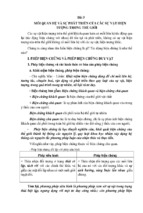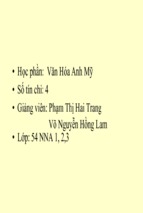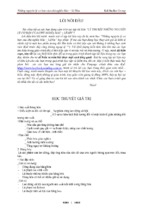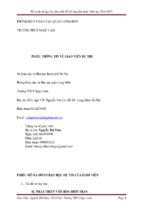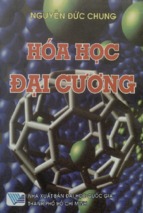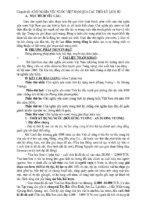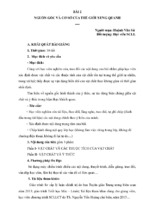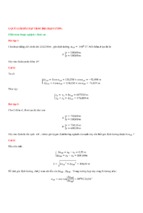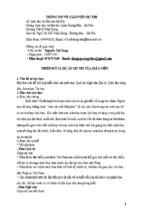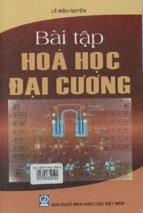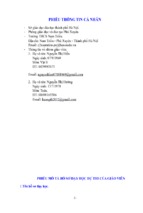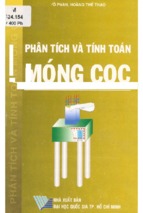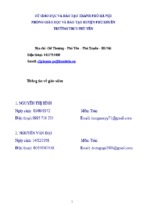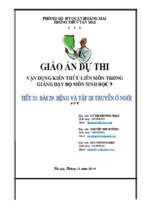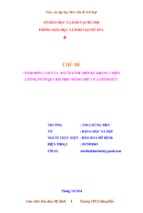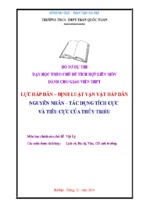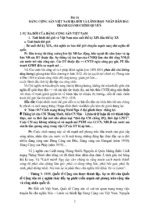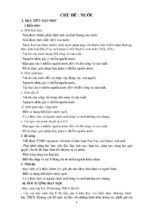vietnam national university, HANOI
hanoi school of business
Nguyen Tat Dat
A study on branding in supermarket,
the case fivimart
master of business administration thesis
Hanoi - 2007
vietnam national university, HANOI
hanoi school of business
Nguyen Tat Dat
A study on branding in supermarket,
the case fivimart
Major: Business Administration
Code: 60 34 05
Master of business administration thesis
Supervisors:
1. Dr. soren kirchner
2. dr. nguyen viet anh
Hanoi – 2007
TABLE OF CONTENTS
Abstract................................................................................i
Acknowledgements .............................................................iii
List of figures...................................................................... iv
List of tables..........................................................................iv
INTRODUCTION ..................................................................................1
1. Necessity of The Thesis ...................................................................... 1
2. Purpose ................................................................................................ 4
3. Key Research Area ............................................................................. 4
4. Methodology ....................................................................................... 4
5. Contribuitons of The Thesis ............................................................... 5
6. Outline ................................................................................................. 5
Chapter 1: Theory Framework............................................................................7
1.1 Understanding Brands .......................................................................... 7
1.1.1 What Is A Brand?........................................................................... 7
1.1.2 Why Do Consumers Like Brands? ............................................... 19
1.2.3 The Difference Between Brand Identity And Brand Image ......... 22
1.2 How Brands Are Built ........................................................................ 25
1.2.1 The Need For A Brand Strategy Blueprint ................................... 25
1.2.2 Creating A Strategic Brand Platform ........................................... 26
1.2.3 Why Brand Personality ................................................................ 28
1.2.4 Values And Characteristics Of Brand Personality ....................... 29
1.2.5 Creating Brand Personality .......................................................... 31
1.2.6 Brand Personality Is Long Term .................................................. 33
1.2.7 Brand Personality Must Be Simple .............................................. 33
1.2.8 Brand Personality And Brand Values .......................................... 34
1.2.9 Creating The Brand Experience ................................................... 35
Chapter 2: Measuring brand success - the use of market research...................37
2.1 Quantitative And Qualitative Research .............................................. 37
2.1.1 Brand Awareness ......................................................................... 38
2.1.2 Brand Associations ...................................................................... 39
2.2 How Does A Brand Make You Feel? ................................................. 40
2.3 Brand Personality ............................................................................... 42
2.4 Perceptual Mapping For Brand Tracking And Strategy ..................... 43
Chapter 3: Strategic communications for brand building.................................44
3.1 Integrated Marketing Communications.............................................. 44
3.2 Communicating Brand Values And Personality................................. 45
3.2.1 Word Of Mouth ........................................................................... 46
3.2.2 Employee Morale......................................................................... 47
3.2.3 Physical Premises ........................................................................ 47
3.2.4 Permanent Exhibits ...................................................................... 48
3.2.5 Public Relations ........................................................................... 48
3.2.6 Corporate Events ........................................................................... 49
3.2.7 Affiliation And Relationship Programs ........................................ 49
3.2.8 Promotions .................................................................................... 50
3.2.9 Sponsorships And Endorsements .................................................. 51
3.2.10 Advertising.................................................................................. 53
3.2.11 Service Standards And Behavior ................................................. 55
3.3 Projecting Several Personality Characteristics Or Brand Values ........ 55
3.3.1 Playing The Brand, Personality Chord .......................................... 57
3.3.2 Combining The Rational And Emotional Messages .................... 59
3.3.3 Mass Versus Individual Communications .................................... 59
3.3.4 Moving From Mass To Relationship Marketing And One-To-One
Marketing .................................................................................................. 60
3.3.5 Relationship Marketing Communications .................................... 61
3.4 The One-To-One Future: Implications For Branding..........................62
3.4.1 Branding And The Internet: Opportunities For Supermarkets ...... 62
3.4.2 Building A Brand On The Internet ................................................ 63
3.5 Using Agencies ................................................................................... 65
3.5.1 The Agency Brief .......................................................................... 65
3.5.2 Tag Line Usage ............................................................................. 66
3.5.3 Choice Of Agency ........................................................................ 67
3.5.4 Communicating During A Recession ........................................... 68
Chapter 4: An actual existence of supermarket branding ................................ 70
4.1 Fivimart Introduction ...................................................................... 70
4.2 Evaluating Of The Marketing Activities For Fivimart ................... 73
4.3 Evaluating The Branding Fivimart Strategy ................................... 76
4.3.1 Objects Of Study ....................................................................... 77
4.3.2 Outcomes Of The Survey .......................................................... 77
4.4 Evaluating The Customer Understanding Fivimart Brand .............. 80
4. 4.1 Introduction.............................................................................. 80
4.4.2 Outcomes Of The Survey .......................................................... 80
CONCLUSIONS AND RECOMMENDATIONS ..................................... 86
REFERENCES ............................................................................................ 90
LIST OF FIGURES
Figure 2-1 Photograph French Wine
Figure 2-2 French Wine Regions
Figure 2-3 Sony electronics products
Figure 2-4 Basic brand structure – Product centered
Figure 2-5 Basic brand structure – Values and Personality centered
Figure 2-6 Sports Starts
Figure 2-7 Singer Stars
Figure 2-8 Entertainer star
Figure 2-9 Action film star
Figure 2-10 Politicians
Figure 4-1 The levi’s brand chord
Figure 5-1 Fivimarts
LIST OF TABLES
Table 1 Customer opinion about Fivimart working style
Table 2 Customer feeling about Fivimart’s brand
Manager’s questionaire table
Customer’s questionaire table
iv
INTRODUCTION
1. Necessity of the Thesis
Retail market in Vietnam has been growing gigantically for 3 years. AT
Kearney, which is the outstanding consulting corporation in the world, have
recently rated our Global Retail development Index (GRDI) at 84 points which
ranks the third in the world retail market, 5 levels higher than the same time last
year.
This is really good news for us because of trustworthy and credible evaluation
in the world.
Especially, there are significant increase in total retail sales and
consumer services turnover (grow by 16.9% per 5 years). Regardless of
inflation (approximately 5.1% per year), these amounts still grow up 11.2% per
year which is a half times higher than economic growth. The growth of total
retail sales and consumer services turnover is caused by many reasons:
population growth, expenditure per capital growth, increasing share of
expenditure by purchasing in the market (from 68.5% in 2000 up to 82.1% in
2005). If local incomes are increasing, shopping styles change so much: more
purchasing, little demur, much concentrating. High-income family make
changes to commodity (industrial products, service replace agriculture, forestry
and aquatic products, more premium products than essential ones and prefer
service to commodity); markets (supermarkets, trading center used more than
outdoor markets, Genuine products take place of second-rate quality ones).
According to Ministry of Trade statistics, total rotation of commodity in
Vietnam reaches 27 billion USD in 2004 and average growth rate has been at
20% in recent years
Even if we have big retail market, high growth rate, there are only 160
supermarkets and 32 trading center nationwide. The country’s outstanding
supermarket chain, which is Co-opmart, has only 13 retail stores. So, Vietnam
is really attractive place for international retailers.
International retail giants’ pressure
Metro, which is the fifth retailer in the world, is one of two first retail
distribution network in Vietnam. It has been licensed to open 4 distribution
centers in Ho Chi Minh City, Hanoi and Can Tho. Metro has recently begun
working on new distribution center in Hai Phong in May this year and July is
for distribution center in Da Nang and taking the second center in Hanoi into
operation.
After setting up successful supermarket in Hanoi, Big C plans to invest
120 million USD in a supermarket networking extending to Can Tho, Da Nang,
Hanoi and HCMC.
In June this year, the third retailer in the world, which is Malaysia’s
Parkson Corporation, took its entrance into our market by setting up a multistorey department store among 10 trading centers in its planning in Vietnam
A source from Ministry of planning and investment, some outstanding
retail corporations in the world have been making research and plan to invest in
Vietnam. Among those are Tesco in UK, which is the sixth retailer in the world
with the turnover of 40 billion USD per year; Giant South Asia Investment Pte
Corporation in Singapore, which has approached the government for a license,
Wal-Mart, which is the biggest retailers in the world and Carrefoul, which is the
second retailer in the world planning to open more centers at main locations in
a near future.
There are many businesses of international retail giants with huge
capital, advanced management technique, business experience as well as global
network support making pressure on local small, spontaneous and weak
distribution system.
Our retailers’ most challenge is to compete unequally with international
corporations with strong financial situation, management skills, well-known
brand name and experience. If these corporations can easily invest millions
USD in building big supermarkets and they are aware of being lost to attract
customers, Vietnamese distributors are in difficulty of capital, human resource
and technology to implement their projects.
One of the most effective ways to compete with retail corporations is to
build up Vietnamese distributors’ brand, promote their supermarket chains and
trading centers by good services and professional management, large numbers
of commodities, reasonable price and good locations…
In next parts, we will deeply get knowledge of understanding brand and the way
to build strong brand name
2. Purpose
Analysis of brand nature under marketing viewpoints. Evaluation of
Supermarket brand in the eyes of Vietnamese consumers. Analysis on facts of
brand, branding and managing brand in Fivimart. Some proposals for Fivimart
to build and manage its brand.
3. Key Research Area
Brand, branding, brand image, brand identity, brand personality, brand strategy,
supermarket, Fivimart.
4. Methodology
The author will give overview of supermarket brand and how to build
strong brand. The background information for this thesis will come from variety
of articles that have appeared in vneconomy, thanhnien, tuoitre, vnexpress,
vietnamnet journals relating to retailer disitributions. Several textbooks from
the field of brand and branding will also be referenced.
There are some important sources of evidence used in case study:
Documents
Interviews
Survey
The data collected will include internal and external data.
External data will include company documents, electronic local newspapers,
business forum, customer survey
Internal data will include interviews, company records, etc
Customer survey and management board survey are using quantitative
and quanlitive research. Managemer concentrates understanding brand and how
to build strong brand.
Customer concentrates brand image and for answer question how choose
of supermarket in their mind.
5. Contribuitons of the Thesis
This thesis aims to clarify an appropriate brand and branding for
Supermarket, and to provide a Intergated marketing communications model for
the use and specification of Fivimart case. The work has involved study brand
and branding theory and drawn out
the pertinent issues which must be
considered when Fivimart managers are built brand awareness.
As part of the evaluation, the thesis also showed the Fivimart managers’s
weakness and solutions for building brand strategy and applied communicating
brand values and personality. Customer survey analysis brand awareness of
choosing supermarket to do shopping and advise fivimart managers some
solutions to improve brand image.
1.6 Outline
The thesis is divided into four chapters:
Chapter 1: Literature Review
Chapter 2: Measuring brand success
Chapter 3: Strategic Communications for Brand Building
Chapter 4: An Actual Existence of Supermarket Branding
CHAPTER 1: THEORY FRAMEWORK
1.1 Understanding Brands
1.1.1 What Is A Brand?
Names, logos, and other visual identities
It is best to start by explaining what a brand is not in order to dispel some
common misconceptions. Based on the origin of branding, it is not surprising to
find that some people think that the basis of modern-day branding is mainly the
use of names, logos, trademarks, and slogans. This is true only to the extent that
they are all used to distinguish companies and individuals from each other in
terms of what they offer. The consistent use of a brand name, symbol, or logo
makes the brand instantly recognizable to consumers and can bring to mind the
personality of the brand and its associations. However, although the visual
element of design is an important aspect of branding, it is insufficient on its
own to make the brand a strong one. It is unfortunate that many companies
believe that a new "corporate identity" in the form of a new logo, new corporate
colors, improved retail-outlet design, a new slogan or tag line, or even a new
name or abbreviation of the old name, can transform the company into a vibrant
force with a grand image. When this happens-and it does-millions of dollars
can be wasted as little thought is given to whether such an overhaul will
improve customer experience or perception of the company, thereby improving
reputation and image. In other words, there is no real brand strategy; a
superficial change in corporate identity alone does not constitute brand strategy.
Still, names and logos are important, especially when building an international
brand. For example, disastrous mistakes can easily be made with names when
venturing into new territory. Even experienced brand builders slip up. When
Coca-Cola entered the Chinese market with the name (literally spelt) "kou-kekou-la." Unfortunately, this meant in Chinese (depending on the translation) "a
thirsty mouth and full of candle wax" or "bite the wax tadpole." The Chinese
name was subsequently changed to "ke-kou-ke- le," meaning "a joyful taste and
happiness" or "happiness in the mouth." This change provided Coca-Cola with
yet another resounding success story. Research is, therefore, a must before
launching anything of a visual nature, especially a name, to the public in any
country.
There is a number of ways by which companies arrive at brand names. But in
all cases, a few guidelines should not be ignored. Names should be:
. simple to spell
. easy to pronounce
. unusual and distinctive
. easy to recall
. protectable e.g. by trademark
. universally acceptable
This is a tall order; not even the Nike brand name is accepted in every country.
But every effort must be made to satisfy all the aforementioned requisites. An
interesting example of product naming is the branding of a particular French
wine in Asia. In Asia, as wine consumers constitute only a minority of the
population, wine is not a mass-market seller. Regarded as an elite product with
many varieties, French wines have names that are difficult to pronounce and
most people cannot distinguish one chateau's product from another, thus
creating confusion.
Figure 2-1 French Wine
List of french wine
Alsace
Beaujolais
Bergerac
Bordeaux known in British English as Claret, includes Medoc, Graves
and Sauternes
Bourgogne or Burgundy including Chablis, Cote d'Or and Maconnais
Jura
Loire Valley, including Muscadet, Vouvray and Sancerre
Rhone Valley including Cotes du Rhone, Châteauneuf-du-Pape and
Crozes-Hermitage AOC
Languedoc wine region Coteaux du Languedoc | Minervois | Corbiéres
Roussillon
One company decided to cut through this confusion and developed a massmarket product. Its strategy to achieve this was by branding an acceptable
French wine with a name that is easily recognizable in any type of outlet,
whether a hotel, bar, restaurant, shop, or supermarket. The company's view was
that the only way to remove the mystique of wines and raise demand from
consumers who know little about them was by branding them. And so the
company did this with a simple, memorable, and recognizable nameMalesan.To raise brand-name awareness, a varied media plan was used, which
included posters, billboards, and a television commercial. The name actually
means nothing, but in Asia the sales response has so far been strong. The
company says the branding has given the product meaning to the consumer.
Is a brand a product?
Some people believe that "brand" is just another word for a product. But basic
products marketed simply as products do not become legends. It is the more
intangible aspects, of value and emotional associations, that wrap around the
product to make it something special. When people think of a product or
service, they usually think of the attributes and features, and the practical
benefits that the product or service will bring to consumers. But when they
think of a brand, they think beyond this and in a totally different way because
branding adds an emotional dimension to the product-customer relationship.
The main aspect that makes brands special is personality. Before we examine
brand personality, what it means to people, and how to build it, it is important
to establish basics of branding in relation to the people's needs.
From product to brand: Basic brand anatomy
Branding is essentially based on the principle of satisfying the needs of
consumers. But people have various needs, some of which can be emotionally
based. Also people do not always act rationally. In order to decide how to build
a brand, a framework that encompasses these different needs must be built. It is
interesting to start from the most basic product or service, and analyze the range
of the needs that might be satisfied by it.
The basic composition of successfully branded products contains two basic
constituents, namely, features and attributes, and emotional benefits. The first is
common to all products, but the second is associated with brands. These
elements tend to be driven by different sets of needs.
Features, attributes, and related practical benefits
These are the main components of a product, service, or company that is going
to be branded. In the case of a company, they could be the size, business focus
(i.e. what a company does), or sales organization of the firm. For a service, they
could include the applicable terms and conditions, and the speed of delivery.
For a product, they could be physical or technical specifications. These features
and attributes satisfy functional needs and are usually not enough to distinguish
a brand from its competition. This does not preclude, however, that if a product
is new, there may be an element of uniqueness when it first enters the market.
Because they are functionally driven, features and attributes are basically
rational by nature, that is, they appeal to a person's logical way of thinking and
of making comparisons. Features and attributes have benefits associated with
them, in terms of how they will satisfy the rational needs and wants of
consumers, and there is a difference between needs and wants. For example,
you might need some food to eat, but you want to eat a steak; you need to wear
casual clothing at weenkend and jeans and T-shirt is your choice to wear .
Features and attributes satisfy rational needs: for example, the fluoride
component of toothpaste helps prevent tooth decay. Meaningful features and
attributes are essential as a pre-condition of entry into the market because if a
product or service does not satisfy the basic needs and wants of consumers, it
will fail. For example, we can name the product of Unilever – that is Viso,
when Unilever buy this product, its awareness in the market is low for
consumers but the way of its advertising is really good, meet customers’
demand. At the time of its launching, many kinds of washing powder have
placed in mind of consumers of clean, so with the slogan of ‚Viso-Clean &
bright‛, Viso have met many house-wives’ demand and improved much its
image. Features and attributes are also relative as consumers compare them
with those offered by competitors. But it is the benefits that satisfy emotional
needs of people that are at the heart of some of the world's most spectacular
brand building.
Emotional benefits
Consumers never really understand all the features and attributes that products
and services have, unlike the companies that produce them. They do, however,
know that they prefer some brands to others. This brand preference tends to
stem from the emotional needs that people have. The secret to branding is in
adding value, especially psychological value, to products, services, and
companies in the form of intangible benefits-the emotional associations, beliefs,
values, and feelings that people relate to the brand. It is this aspect of the
product or service, and not the features and attributes, that can strongly
distinguish in people's minds one brand from another. This can be achieved by
building a strong identity or personality for the brand, and strategically
positioning it in the minds of the target audience. This is not an easy or quick
process, but it is absolutely vital to brand success. It is really true for beer
industry in Vietnam market, that’s Heniken for businessmen and high-ranking
class but Hanoi for social class in the society. We also can name products in the
cosmetic industry, like Channel or Lovite – Paris for high-ranking women but
Korean cosmetics for social ones (Essanse, LG…)
Figure 2-3 typifies brands that emphasize functional characteristics. Companies
using this approach concentrate on promoting their brands on the basis of the
functional features and competencies the brands possess. An example of this
would be the brands built by companies such as Sony Corporation.
We can identify its electronics products: they have wide-range of products like
Digital Cameras, DVD recorder, walkman…
Figure 2-2 Sony electronics products
We go deeply to the way Sony Corporation market its Digital Camera-Cyber
shot since the year of 1996. In 1996, its product had only 0.35 mega pixel,1998
upgraded to 2.11 mega pixel and now is 5.1 mega pixel and have many much
more functions, like rotating lens with 3 times optical zoom, LCD minitor,
shooting functions… but Sony still base on its core message for this product: to
become the One and Only, fulfilling the excitement of owning, shooting and
viewing.
The features define the core product, while quality, reliability, service aspects,
and reputation form the relevant brand benefits.
An alternative approach to brand building is to center the brand
Figure 2-3 Basic brand structure: Product-centered
Figure 2-4 Basic brand structure: Values and personality centered
around its core values, usually personality characteristics, and then build
product (service or company) features, attributes, benefits, or imagery around
- Xem thêm -

